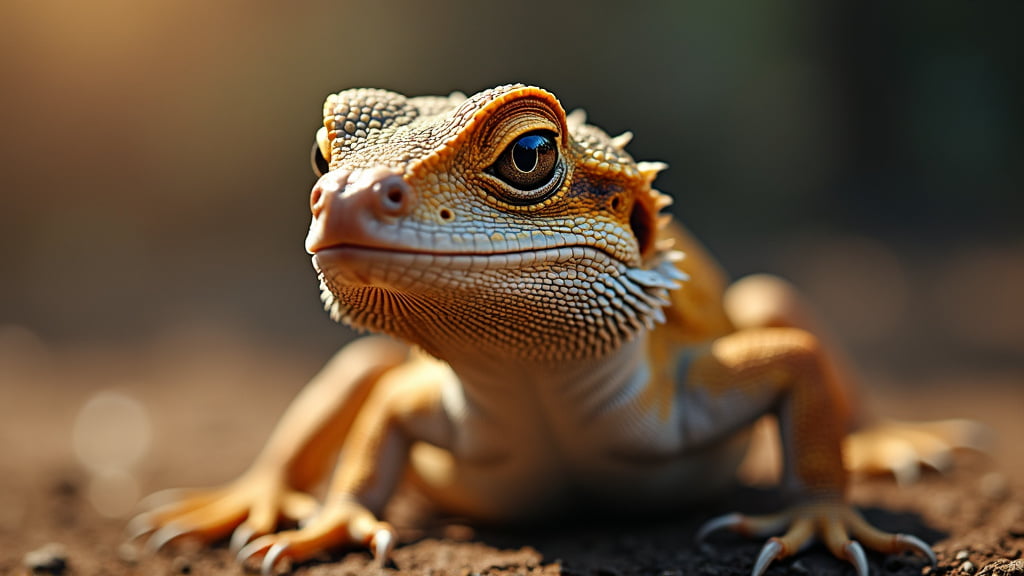Heat Lamps vs. UVB Bulbs: Essential Lighting for Happy, Healthy Bearded Dragons
Meta Description: Discover the key differences between heat lamps and UVB bulbs for bearded dragons. Ensure optimal health and happiness for your pet with expert advice on lighting.
Introduction
If you’re a bearded dragon owner or considering becoming one, understanding their lighting needs is crucial. Proper lighting isn’t just about making your vivarium look good; it directly impacts your bearded dragon’s health and well-being. Heat lamps and UVB bulbs are the two primary types of lighting you’ll need, but what are their distinct roles, and how do you choose the best for your scaly friend? Let’s dive into this illuminating topic and shed some light on the essentials for your bearded dragon.
The Role of Heat Lamps
Why Bearded Dragons Need Heat Lamps
Heat lamps provide the warmth bearded dragons need to thrive. Native to the arid Australian outback, these reptiles rely on external heat sources to regulate their body temperature. Heat lamps help replicate the basking conditions they would naturally seek in the wild.
Key benefits of heat lamps:
- Thermoregulation: Bearded dragons are ectothermic (cold-blooded) and depend on external heat sources to regulate their body temperature.
- Digestion: Appropriate heat aids in digestion, preventing issues like impaction.
- Activity Levels: Adequate warmth keeps your dragon active and alert, promoting a healthier, happier pet.
Setting Up the Perfect Basking Spot
Creating a basking spot with a heat lamp is crucial. Here’s how to set it up:
Choosing the Right Heat Lamp
Not all heat lamps are created equal. Trust me, after years of tweaking and experimenting, I’ve found the following to be critical:
- Wattage: Typically, a 75-100 watt lamp works well for a standard-sized enclosure. Adjust based on your tank’s dimensions.
- Ceramic vs. Standard Bulbs: Ceramic bulbs can provide consistent warmth without emitting light—a good option if you need nighttime heating.
Placement and Temperature Monitoring
Proper placement ensures maximum effectiveness:
- Distance: Place the lamp at one end of the tank to create a temperature gradient.
- Height: Ensure it’s at a safe distance to prevent burns but close enough to provide adequate heat.
- Thermometers: Use digital thermometers (one near the basking spot and one on the cooler side) to monitor temperatures. Aim for 35-40°C (95-105°F) at the basking spot and around 24-29°C (75-85°F) on the cooler side.
The Importance of UVB Bulbs
UVB Lighting and Bearded Dragon Health
UVB lighting is just as crucial as heat for bearded dragons:
- Vitamin D3 Synthesis: UVB helps bearded dragons synthesise vitamin D3, necessary for calcium absorption.
- Preventing MBD: Without UVB, bearded dragons are at risk of Metabolic Bone Disease (MBD), which can be fatal.
Types of UVB Bulbs
There are two primary types of UVB bulbs you’ll encounter:
Fluorescent Tubes
- Coverage: Provide even UVB distribution, essential for larger enclosures.
- Longevity: Generally last longer, about 6-12 months before needing replacement.
- Options: T5 and T8 tubes are common, with T5 offering higher UV output.
Compact Bulbs
- Space Efficiency: Ideal for smaller setups.
- Positioning: Need to be positioned within 20-30 cm of the basking spot to be effective.
Setting Up UVB Lighting
Ensure effectiveness by considering the following:
- Fixture: Use a reflector to maximize UVB output.
- Screen Lids: Some screens can block significant UVB. Choose one that allows proper penetration.
- Regular Replacement: UVB output diminishes over time, so mark your calendar for regular replacements.
Balancing Heat and UVB
Creating the Optimal Environment
Combining heat and UVB effectively creates a balanced, naturalistic environment. Here are some tips:
- Combo Fixtures: Use fixtures that combine both heat and UVB bulbs for convenience and efficiency.
- Natural Light Cycles: Mimic natural day-night cycles with timers. Aim for 12-14 hours of light during the day.
- Seasonal Adjustments: Slightly adjust the duration and intensity of light to mimic seasonal changes.
Monitoring and Adjusting
Your bearded dragon’s behaviour and health are the best indicators of your setup’s success:
- Basking Behaviour: If your dragon is constantly basking, the environment might be too cold. If avoiding the basking spot, it might be too hot.
- Health Signs: Keep an eye out for signs of MBD, such as lethargy, lack of appetite, or swollen limbs, and consult a vet immediately if you notice these symptoms.
Conclusion
Proper lighting is non-negotiable for the health and happiness of your bearded dragon. Heat lamps and UVB bulbs each play vital, distinct roles in creating a suitable environment for these fascinating reptiles. Understanding their specific needs and setting up your vivarium accordingly will ensure your bearded dragon thrives.
For more tips on bearded dragon care, explore our other guides and join our community of reptile enthusiasts. Remember, always consult with a vet for any specific health concerns. Light the way to a happy, healthy bearded dragon today!
Internal Links
- Bearded Dragon Lighting
- Bearded Dragon Diet: What They Should Eat
- Understanding Bearded Dragon Behaviour
By following these guidelines, you’ll ensure your bearded dragon is as comfortable and healthy as possible, bathed in the right light!




